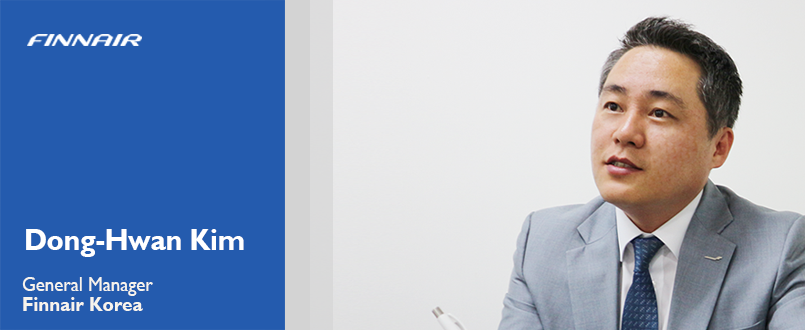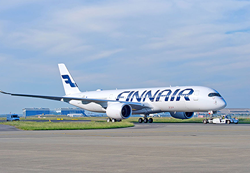

As one of the safest and
longest-operating airlines in the world,
Finnair is securing its foothold in Korea and beyond
For many of us, a long overseas
flight is the stuff of nightmares.
Cramped seating, lost baggage
and flight delays can wear down
even the most seasoned traveler (And seriously, what’s the deal with airplane food?).
Add to that the barrage of negative press
surrounding airline customer service, and
you have major carriers scrambling to do
damage control in response to falling profits. But things couldn’t be more different
for Finnair—an airline dedicated to going
above and beyond to wow passengers.
Founded in 1923, Finnair is one of the
world’s oldest operating airlines. Based in
Vantaa, Finland, it specializes in flying
between Europe and Asia along the shorter
northern route while providing customers
with a unique Nordic experience. In a time
where many airlines are skimping on crew,
Finnair started the biggest recruitment in
its history in 2015 and plans to recruit 350
new flight attendants and stewards by
2018. As a result of its dedication to
improving customer satisfaction and safety, Finnair was named ‘Northern Europe’s
Best Airline’ at the World Airline Awards
at the Paris Air Show for eight consecutive
years. The results are based on an independent survey of more than 19 million
passengers from 105 countries.
Additionally in January, the OAG
Punctuality League publication ranked
Finnair’s arrival punctuality in 2016 (84.12
percent) as the 16th highest in the world.
For Finnair, the journey to the destination is just as important as the arrival. With
the addition of the A350 aircraft in 2015,
Finnair's planes combine the latest technology with advanced passenger comfort fea-
tures. The carrier's state-of-the-art Nordic
Sky entertainment system and Wi-Fi keeps
passengers better connected and more
entertained during their journey with an
improved range of entertainment options
for a more enjoyable and peaceful flight.
Nordic Sky’s unique program, displayed
on 16-inch touch screens in business class
and on 11-inch screens in economy class,
shows the main stages of the flight, guiding passengers from departure throughout
all stages of their journey, informing them
when meals will be served, when rest
lighting will be activated and when they
can make purchases from the in-flight
shopping service. This enables travelers to
manage their time on-board effectively.
Along with European travelers, passengers from Asia are Finnair’s most frequent
customers. One of its main objectives by
2020 is to double its
Asian traffic volume
from 2010. “The cornerstone of the company’s strategy is leveraging its geographical competitive advantage and the fastest
connections in the growing market of air
traffic between Asia and Europe,” says
Dong-Hwan Kim, general manager of
Finnair Korea. “It’s also the only European
airline that can operate flights to most
Asian destinations on a 24-hour aircraft
rotation, which means that the routes can
be operated as round trips within 24 hours
at regular times using a single aircraft.”
It’s this kind of efficiency that enables a
record-high utilization rate in long-haul
traffic, reduces the need for additional
crew due to flight time restrictions and
decreases fuel consumption and emissions
thanks to shorter flight times.
Due to the growing number of travelers
going in and out of Korea, Finnair established a Korea branch office in January
2007, operating direct flights between
Helsinki and Seoul from June 2008. Kim
says that more Koreans are becoming
interested in Nordic culture, its education
system

and beautiful landscape.
Despite its strong presence in the global
arena, Finnair knew that it had to do more
to woo Korean passengers when it first
entered the local market. To provide the
highest level of service and convenience,
the company hired Korean cabin crew
members, constructed Korean signs at the
Helsinki airport and provided in-flight
Korean meals. Most notably, it implemented the Finnair Plus mileage program
so that customers can stack points and
redeem them for gift cards at Korean
department stores. As a
result, Korea has the second highest number of travelers
using Finnair Plus points.
The airline also partnered with Finnish
design house Marimekko since 2012 to
provide everything from tableware to fabrics for the aircraft. “The calm blue, green
and light grey tones and the classic prints
used in the Marimekko for Finnair collection are a perfect reflection of the Nordic
tranquility and comfort that is present on
our flights,” says Kim. “All the materials,
including the light porcelain used in the
business class tableware, are specially
designed for aircraft usage.”
Although Korea has proved to be a suitable market for Finnair, Kim notes that
regulations in the country should be eased
because they're a bottleneck for foreign
investors in the market as other countries
have different
regulations. He adds that
Korea could become a more optimal business environment by implementing market protectionist policies that don’t restrict fair
competition.
So what’s next for Finnair? Because
Finland is still an unfamiliar country to
many Koreans, the company is working
with Visit Finland to promote ‘Stopover
Finland’, a program where travelers can
experience and explore the country from
five hours to five days. Kim says that
Finnair will continue to invest in accelerated growth and embrace the business and
digital transformation.